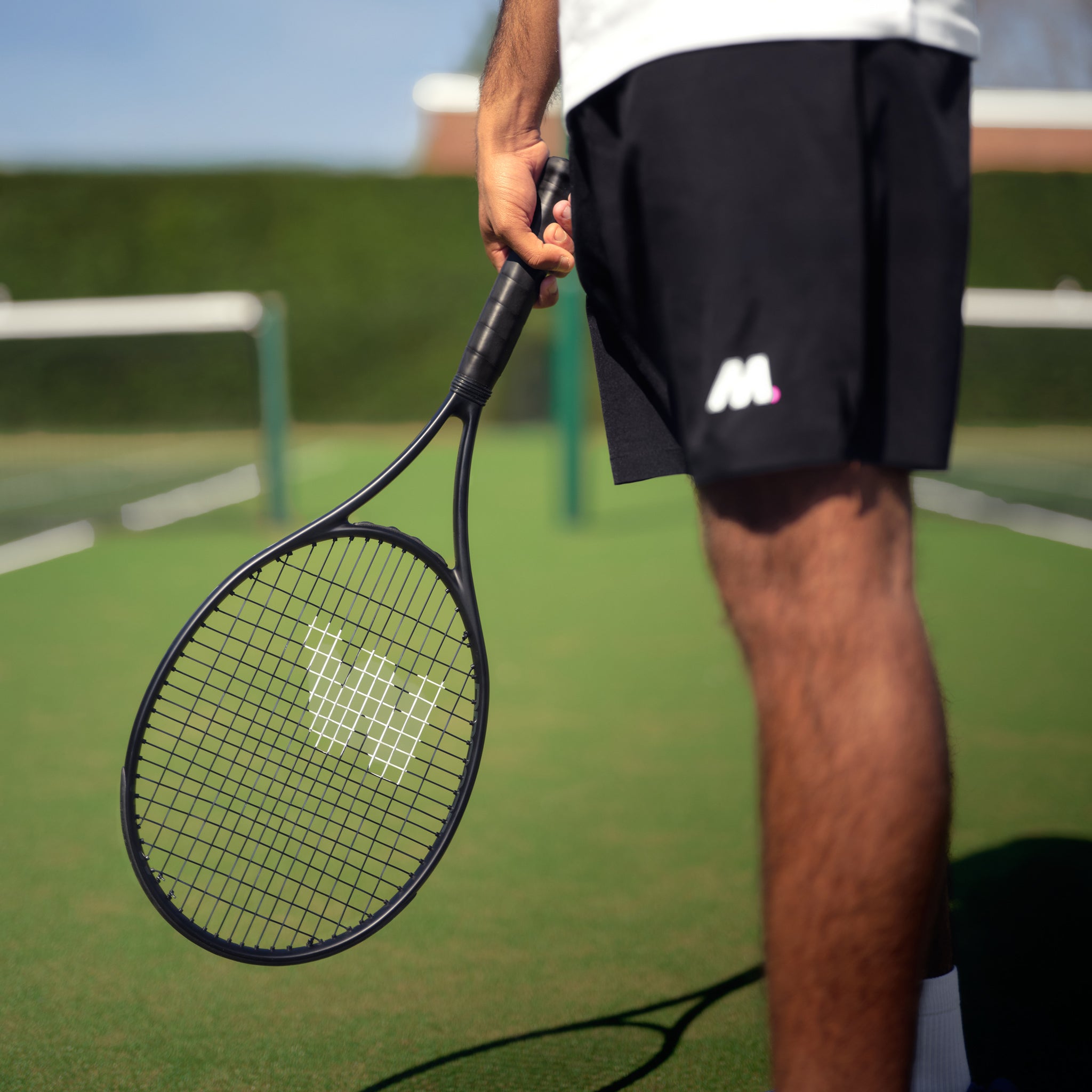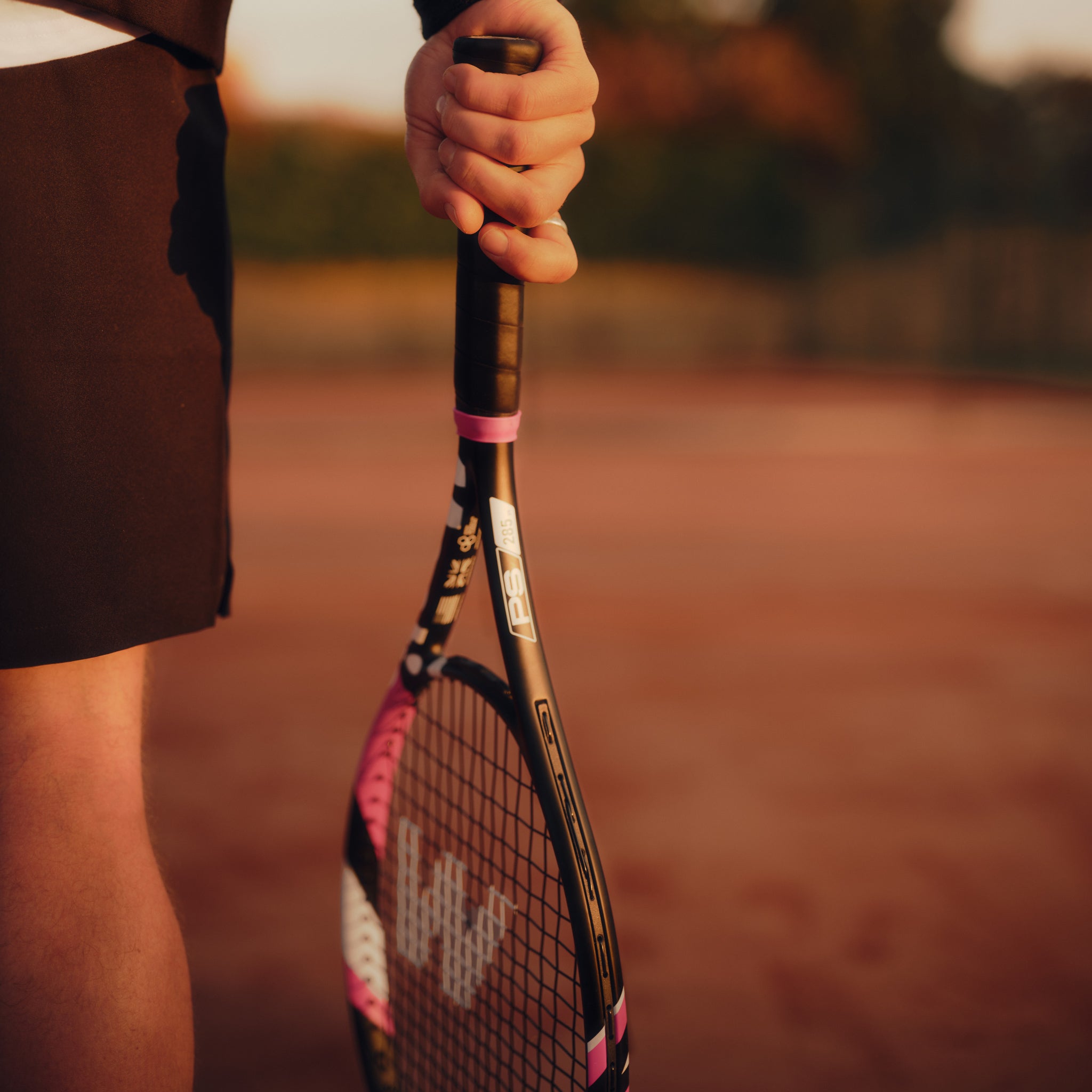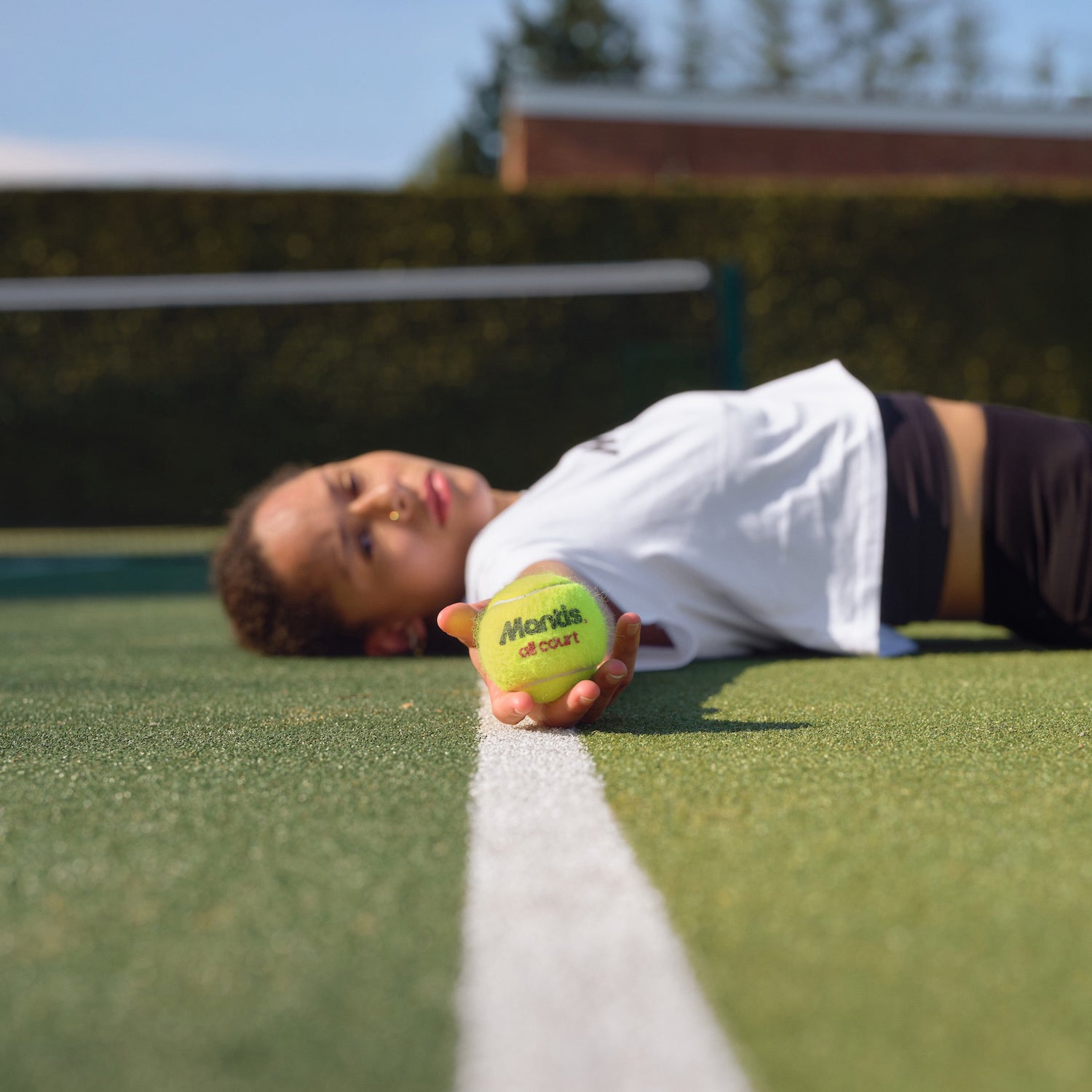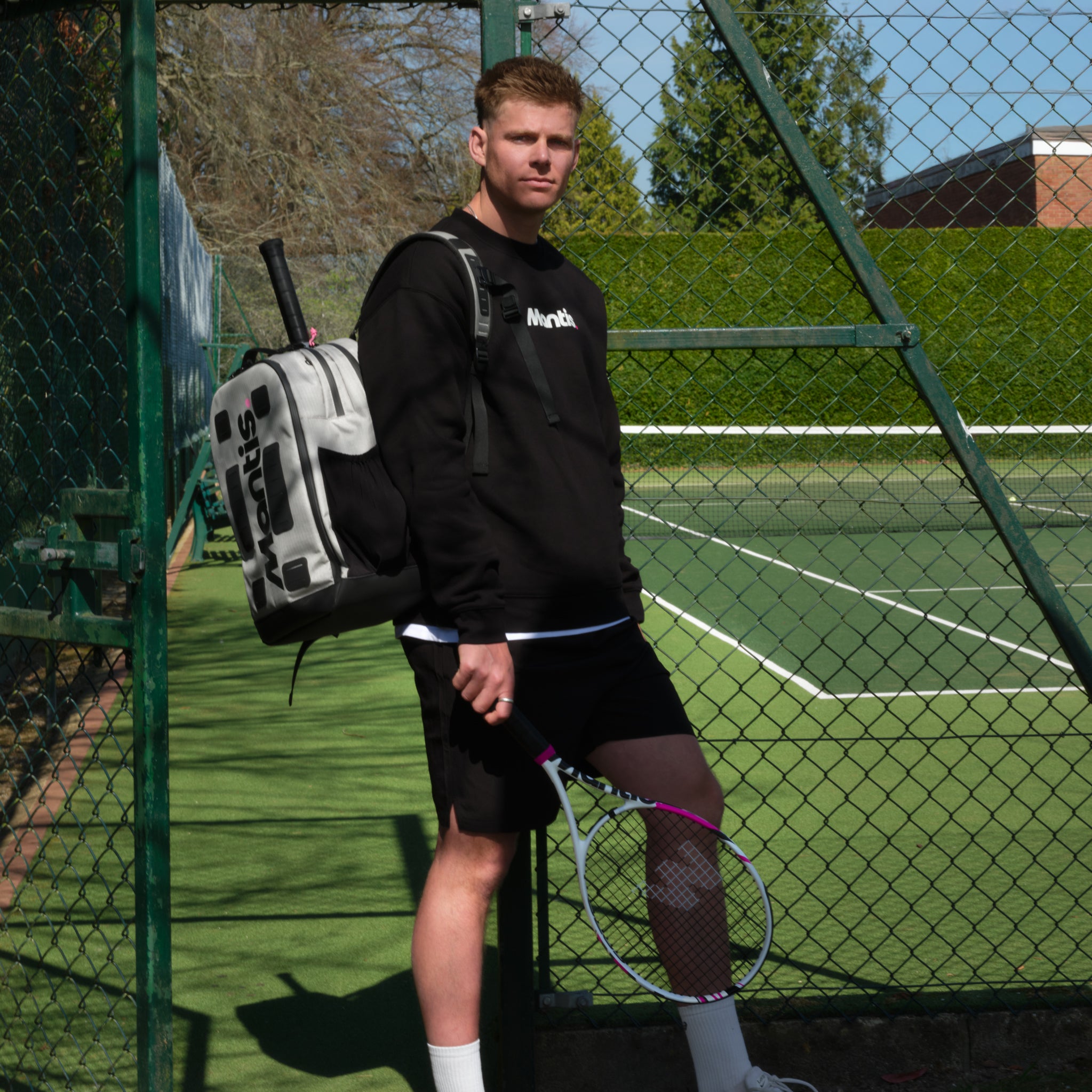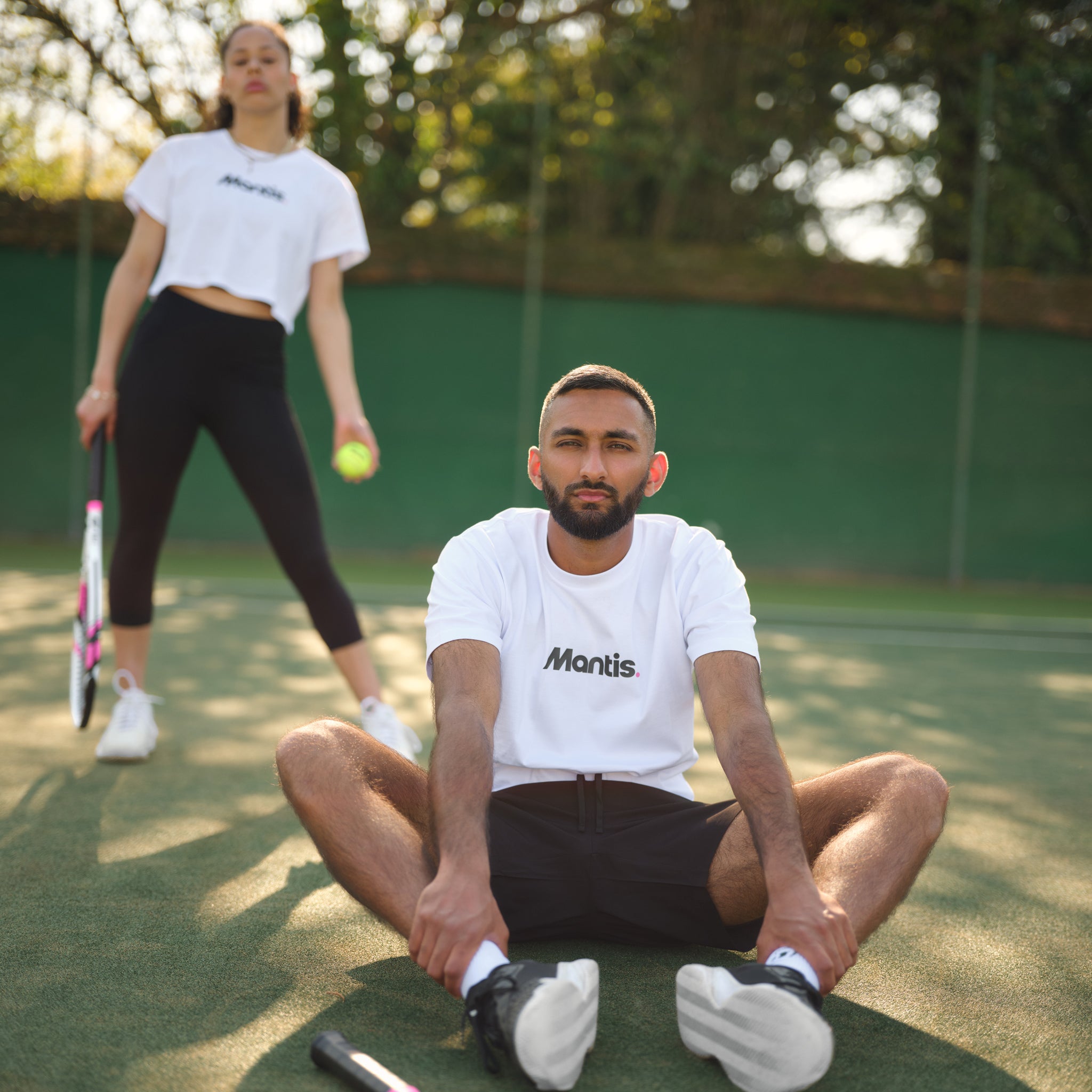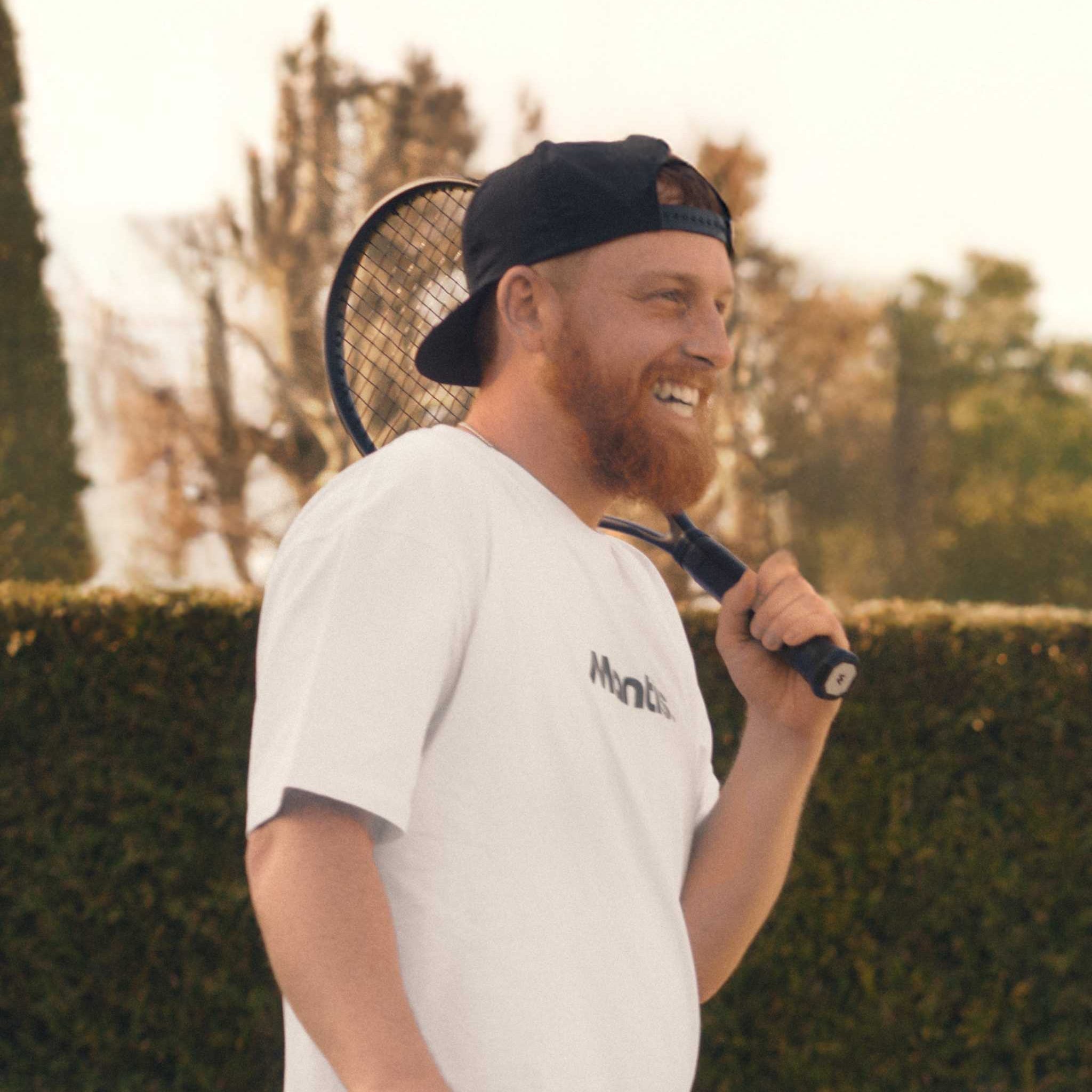
When you're looking to improve your hand eye coordination, the best approach is to consistently practice specific drills that really challenge your visual tracking and motor skills. At Mantis, we've found that exercises like juggling, wall ball throws, or even using unpredictable reaction balls are highly effective. It all comes down to consistency; these activities forge stronger neural pathways between your eyes, brain, and hands, which ultimately leads to quicker reactions and much better precision on the court.
Hand eye coordination: The Hidden Engine Behind Athletic Success
Ever wondered what really separates a good athlete from a truly great one? More often than not, it boils down to exceptional hand-eye coordination. We see this as the absolute foundation of athletic performance.
At its core, this skill is a lightning-fast sequence: your eyes spot and track an object, your brain instantly calculates its speed and trajectory, and your hands move to intercept it with incredible accuracy. This all happens in a split second. For a tennis player, that’s the difference between shanking a serve and smashing a clean winner down the line. It's the hidden engine driving every single successful shot.
Why It Matters on the Court
Working on this fundamental skill isn't just about getting a little faster; it provides real, tangible advantages during a match. When you train it consistently, you sharpen those crucial neural connections, which brings some major benefits to your game.
For starters, better coordination helps you read your opponent's game. Your brain gets quicker at predicting where the ball is heading, giving you that vital extra moment to set your feet and prepare your swing. You start anticipating, not just reacting.
The ability to process information received through your eyes to control, guide, and direct your hands is a learned skill. It’s developed through repetition and practice, not something you're simply born with.
The Brain-Body Connection
When you get right down to it, training your hand-eye coordination is really about training your brain. Every time you run through a drill, you’re strengthening that communication line between what your eyes see and what your body does. This creates a much more efficient and reliable connection, which is exactly what you need when you're under pressure in a tight match.
This improved efficiency leads directly to:
- Faster Reaction Times: The gap between seeing the ball and moving to it shrinks, meaning you can handle those blistering serves and quick-fire volleys at the net.
- Pinpoint Accuracy: Your ability to direct the racquet to a specific point in space becomes second nature, leading to far more precise and effective shot placement.
- Confident Execution: When you have complete trust that your eyes and hands are in sync, you play with more freedom and confidence, allowing you to commit fully to every shot.
Ultimately, figuring out how to improve hand-eye coordination is the first real step to unlocking your potential. It’s the one skill that transforms raw athletic talent into precise, match-winning action.
Building Your Coordination Foundation Off the Court
The brilliant thing about improving hand-eye coordination is that you don't always need a tennis court. In fact, you can make huge strides in building your visual-motor skills almost anywhere, with just a few simple tools and a bit of consistency.
Think of these off-court drills as laying the groundwork. While they directly support your game, they also tap into fundamental physical skills. This is why a balanced routine that includes essential tennis strength training is vital for overall development as a player. By breaking down coordination into its core parts, you can hone the muscle memory and sharpen the neural pathways that translate to clutch plays on the court.
Drills to Sharpen Your Reflexes and Vision
At Mantis, we're big believers in integrating a few key drills into your weekly routine. They work because they force your brain to process visual information and react under pressure, which is exactly what happens in a fast-paced match.
Juggling is a fantastic place to start. It’s not just a party trick; it's a phenomenal way to expand your peripheral vision and teach your hands to move in perfect sync. Begin with two balls in one hand, then work your way up to three. The goal is a smooth, continuous rhythm.
Another simple but incredibly effective tool is a wall and a tennis ball. Bouncing a ball against a wall is all about improving your predictive tracking—your brain’s ability to guess where the ball is going next. Don't just get into a boring rhythm, though. You need to mix it up:
- Play with distance: Stand closer for quick reactions, then step back to give yourself more time.
- Switch it up: Try catching with your non-dominant hand. It’ll feel awkward at first, but it's great for building well-rounded skills.
- Add some spin: Put a little slice or topspin on your throw. The unpredictable bounce off the wall will keep you on your toes.
The secret to making these simple drills work is to constantly change the variables. When you stop your brain from getting comfortable, you force it to adapt. That's where real, lasting improvement happens.
Adding Dynamic Tools to Your Training
Ready to take it up a notch? Get yourself a reaction ball. These little odd-shaped balls bounce in completely random ways, giving your nervous system a serious workout. Just dropping and catching one for 5-10 minutes a few times a week can make a noticeable difference in your reaction speed.
It’s also worth looking at other sports that demand precision and fast reflexes.
The key to all this is consistency. Aim to weave these off-court sessions into your schedule at least three times per week. Before you know it, you'll feel that newfound quickness and confidence the next time you step onto the court.
Advanced Drills for On-Court Mastery
Getting the basics down is one thing, but translating that general coordination into match-winning shots is where the real work begins. To forge genuine on-court mastery, you need to bridge the gap between simple practice and the high-pressure reality of a competitive game. This means running advanced drills that feel just as chaotic and fast-paced as a real point.
These exercises are designed to push your visual processing and motor skills right to the edge, forcing your brain and body to connect and adapt in the blink of an eye. We're moving beyond rote repetition here. The goal is to build the resilience you need to handle whatever your opponent decides to throw at you. For anyone looking to really sharpen their net game, our guide on essential tennis volley drills is the perfect next step after mastering these.
Dynamic Drills for Match-Ready Reflexes
The whole point of this on-court work is to create scenarios that feel completely unpredictable. At Mantis, we recommend drills that force you to adapt instantly, simulating everything from a blistering serve return to a last-second dash for a drop shot.
A fantastic one to try is the unpredictable volley-volley exchange. You and a partner stand at the net and start a rapid volley rally. The trick? Both of you should constantly vary the pace, spin, and direction of your shots without any warning. This kills any sense of rhythm and forces you to react purely on instinct, training you to read the ball right off your opponent's strings.
Another killer drill is rapid-fire feeding. Get a coach or a friend to stand at the net and feed you a quick succession of balls to all corners of the court. The sequence has to be random—a deep forehand, followed immediately by a short backhand slice, then a high lob. It's a brilliant way to train your footwork and reaction time together, teaching you to recover and set up for the next shot in a split second.
The secret is what we call controlled chaos. When you deliberately create unpredictable situations in practice, you're training your mind to stay calm and your body to react instinctively when the pressure is really on.
Forcing Precision With Specialised Gear
If you really want to level up your training, you can bring in some specialised equipment to force a higher level of focus. One of the most effective ways to do this is to practise with a smaller-headed racket. This isn't about hitting harder; it’s all about demanding absolute precision.
When you use a smaller frame, your margin for error shrinks dramatically. This forces you to watch the ball onto the strings and find the sweet spot on every single shot. After a session with a smaller racket, your regular frame will feel massive, and you’ll notice a real difference in your timing and accuracy.
Research from the UK actually backs this up, showing just how crucial this kind of focused sports training is. One study found statistically significant differences in coordination between students who played sports and those who didn’t.
Here are a few specific goals to aim for with these advanced drills:
- Improve Serve Return Reaction: Have a partner serve at you, but they have to mix up the speed and placement without telling you what’s coming next.
- Sharpen Drop Shot Defence: Get your partner to feed you deep groundstrokes but randomly throw in a drop shot to test your anticipation and delicate touch.
- Enhance Net Play Adaptability: Try volley drills where your partner aims shots right at your body, forcing you to make quick, unconventional blocks and adjustments.
By weaving these demanding, game-like drills into your training, you’re not just practising strokes. You're building the mental and physical toolkit you need to perform when it really counts.
Tapping into Tech to Fast-Track Your Progress
While nothing can replace the hard yards you put in on the court, modern technology offers some brilliant ways to sharpen your skills and get ahead. Think of these tools not as a substitute for your physical drills, but as a powerful training partner for your brain.
At Mantis, we've seen firsthand how integrating the right tech can help players break through frustrating performance plateaus. These tools target the cognitive side of coordination – the rapid-fire decision-making and visual processing that happen in the split second before you even swing. It’s about giving yourself a competitive edge by training smarter, not just harder.
Getting Started with Cognitive-Motor Training Apps
One of the easiest ways to dip your toes into tech-based training is with interactive cognitive-motor training (ICMT) apps on your phone or tablet. They essentially turn crucial reaction drills into engaging games, challenging your reaction time, predictive skills, and visual tracking. The whole point is to train your brain to process what it sees faster and more accurately.
And it’s not just a gimmick for younger players. A UK-based study found that after just eight weeks of ICMT (three 30-minute sessions per week), participants showed real, measurable gains in visual-motor integration, visual perception, and motor coordination. These are the very skills that separate a good shot from a great one.
Immersive and Sensory Training Tools
If you're ready to take things a step further, some incredible tools are available that create challenging sensory environments, forcing your visual system to level up.
-
Virtual Reality (VR) Systems: Imagine facing a big server's best shot a hundred times in a row without any physical fatigue. VR makes that possible. It offers hyper-realistic match simulations, allowing you to practise reading specific plays and shot patterns repeatedly.
-
Strobe Glasses: These are a fascinating bit of kit. The glasses work by creating a stroboscopic effect, which means they flash between clear and opaque, intermittently blocking your vision. This forces your brain to work overtime to predict the ball's path with less information, making your visual processing far more efficient.
The real magic of these technologies is their ability to isolate and overload specific parts of your hand-eye coordination. By pushing your visual system in a controlled, deliberate way, you're building a more resilient and adaptable neural foundation for when you get back on the court.
Choosing the right tool really comes down to your budget and what you want to achieve. Before you invest, it's worth weighing up the options.
Coordination Training Tool Comparison
| Tool/Technology | Primary Focus | Best For | Typical Cost |
|---|---|---|---|
| Cognitive-Motor Apps | Reaction time, decision speed, visual tracking | A low-cost, accessible starting point for all levels | £0 – £20/month |
| Virtual Reality (VR) | Realistic match simulation, pattern recognition | Tactical development and rehearsing specific scenarios | £300 – £2000+ |
| Strobe Glasses | Enhancing visual processing speed, prediction | Advanced players looking to sharpen their focus | £150 – £500 |
| Reaction Lights | Agility, reaction speed, peripheral vision | Off-court conditioning and explosive movements | £200 – £1000+ |
Ultimately, whether you opt for an app or a full VR setup, weaving any of these into your routine introduces a new kind of challenge. It keeps your mind sharp and your body constantly adapting—and that's the secret to unlocking your next level of performance. The other suggestion is to speak to a coach as they will be able to offer additional advice.
Fine-Tuning Your Game Off the Court
Great hand-eye coordination isn’t just built during practice sessions; it’s sharpened by the choices you make every single day. Think of it this way: your on-court skills are only as good as the foundation you build off the court. We see this all the time—the small, consistent habits are what separate the good players from the truly great ones.
It’s all connected. What you eat, how much water you drink, and the quality of your sleep directly impact how well your brain and body communicate. These aren't just 'healthy habits'; they are performance essentials that keep the neural pathways between your eyes and hands firing on all cylinders.
Train Your Eyes Like Any Other Muscle
You wouldn't skip leg day, so why neglect your eyes? Just like any other muscle group, your eyes need training. Simple vision exercises can make a huge difference in strengthening the muscles that control eye movement and, more importantly, improving how your brain processes what you see. The goal is to track the ball better, nail your distance judgements, and react in a split second.
Here are a few simple drills you can weave into your daily routine:
- Bead String Tracking: This is an old-school classic for a reason. Thread a few beads onto a string and hold one end to your nose. Focus on a single bead as you slide it back and forth, working to keep it in sharp focus. It’s a fantastic way to train your eyes to work together smoothly.
- The Pen Push-Up: A simple drill for depth perception. Hold a pen out at arm's length, focusing on the very tip. Slowly bring it towards your nose until your vision starts to double, then move it back out. Doing this repeatedly helps you judge the ball’s speed and distance much more accurately.
- Peripheral Vision Test: Stare at a fixed point on a wall straight ahead. Now, without shifting your gaze, try to identify objects or even just colours and shapes in your periphery. This is crucial for catching your opponent’s movement out of the corner of your eye during a match.
These aren't overnight fixes. Think of them as long-term investments in your athletic hardware. You're fine-tuning the very sensory system that controls every shot you make.
By dialling in on your off-court habits—from your diet and sleep to these specific eye drills—you're building a more robust, responsive athletic machine. It's these behind-the-scenes efforts that truly make the difference when the pressure is on.
Why Coordination Is a Lifelong Skill
The ability to seamlessly connect what your eyes see with what your hands do is a skill that pays dividends long after you've stepped off the tennis court. Here at Mantis, we see hand-eye coordination not just as a tool for athletic performance but as a genuine investment in your lifelong well-being. It's a foundational skill that supports everything from simple daily tasks to complex brain functions as we get older.
This connection between mind and body starts incredibly early. The motor skills we build as children, usually through simple play, have a direct and lasting impact on academic abilities like reading and writing. When you start to view coordination training as a core life skill, it provides a much deeper motivation than just winning your next match. You're not just training for today; you're investing in your future health.
The Surprising Link Between Motor Skills and Academic Success
It might sound like a bit of a leap to connect a powerful forehand with better exam results, but the science behind it is solid. The very same neural pathways that let a player track a screaming yellow ball are also involved in tracking words across a page. This isn't just theory; it's backed by significant research.
A fascinating study in Bradford, West Yorkshire, followed over 300 children between the ages of 4 and 11. The results were clear: those with better eye-to-hand coordination consistently scored higher in reading, writing, and maths. In fact, the children who excelled at computer-based tracking tasks were, on average, a full nine months ahead academically.
This brings up a crucial point. When we train our coordination, we're not just working our muscles. We're actively sharpening the brain's ability to process information and execute precise movements—a skill that's invaluable in every part of life.
This data shows just how quickly targeted training pays off. In only four weeks, consistent coordination work slashed reaction times from a 300 ms baseline down to just 200 ms. As the chart shows, that's a 33% improvement in reaction speed in just one month. It’s proof that the right drills deliver tangible, measurable results, fast.
Maintaining Cognitive Function in Later Life
The benefits don't fade away after your school years. As we age, keeping our motor skills sharp is absolutely vital for preserving cognitive function and staying independent. Activities that constantly challenge hand-eye coordination—like playing tennis, juggling, or even video games—help keep our neural connections strong and responsive.
This kind of regular engagement supports skills that are critical for day-to-day living:
- Maintaining Balance: Quick reactions are your first line of defence against falls.
- Preserving Fine Motor Skills: These are essential for everyday tasks like writing, buttoning a shirt, or cooking.
- Supporting Cognitive Agility: Challenging your coordination keeps your mind sharp and engaged.
Think of it this way: every drill you do on the court is another deposit into your long-term cognitive and physical health account. By embracing coordination training as a lifelong practice, you are actively building a more resilient, capable, and healthier you for the years ahead.
At Mantis, we craft high-performance tennis gear for players who are serious about their game. Discover our range of precision-engineered rackets, balls, and accessories at https://mantissport.com.
